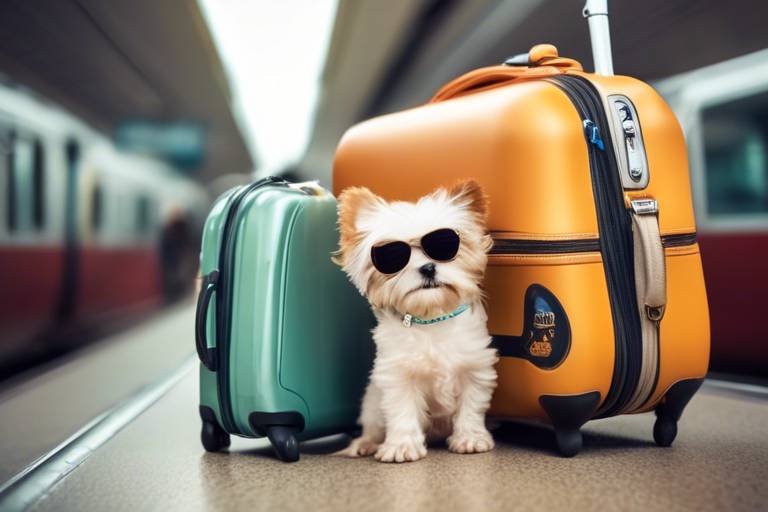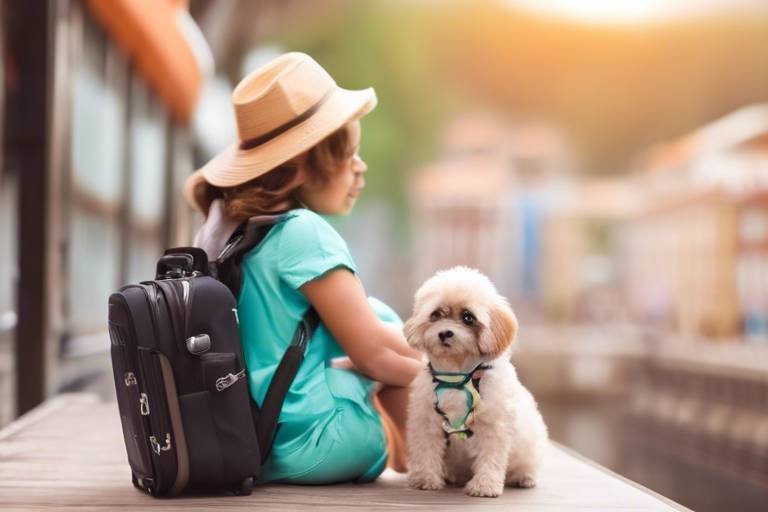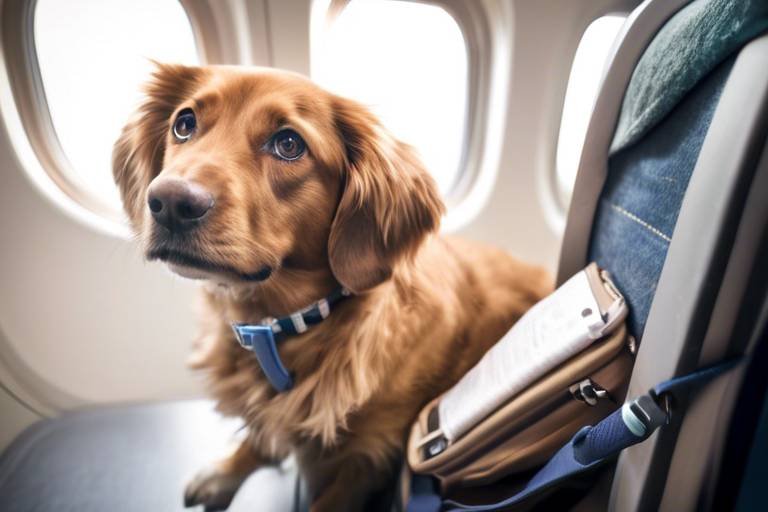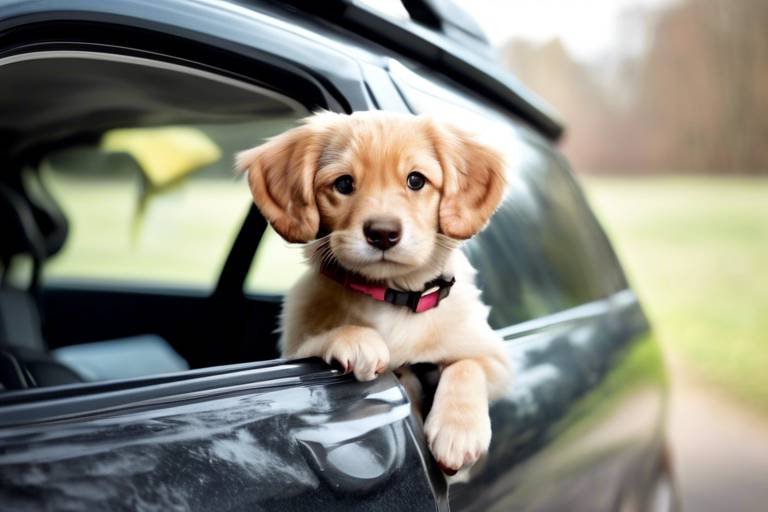Tips for Finding the Right Pet Travel Equipment
Traveling with your furry friend can be one of the most rewarding experiences, but it also comes with its own set of challenges. Choosing the right pet travel equipment is crucial for ensuring that your pet enjoys a safe and comfortable journey. So, what should you consider when selecting the best gear for your beloved companion? Let's dive into some essential tips that will make your travels smoother and more enjoyable for both you and your pet!
Before you even think about what equipment to buy, it's vital to assess your pet's specific needs. Each pet is unique, and factors such as size, breed, and temperament play a significant role in determining the right travel gear. For example, a small, calm dog may be perfectly comfortable in a soft-sided carrier, while a larger, more energetic breed might require a sturdier crate. Take a moment to consider the following:
- Size: Ensure the equipment is appropriate for your pet’s size. A cramped space can lead to anxiety and discomfort.
- Breed: Some breeds have specific needs, especially those prone to anxiety or health issues.
- Temperament: An anxious pet may require calming accessories like blankets or familiar toys.
Now that you have a grasp on your pet's needs, let’s explore the various types of pet travel equipment available. Each type serves a unique purpose and can significantly enhance your pet's travel experience. Here are some essentials to consider:
Selecting the right carrier or crate is vital for your pet's safety. Not only does it provide a secure space for your pet, but it also helps in reducing their anxiety during travel. When choosing a carrier, consider the following:
- Size: Your pet should be able to stand up, turn around, and lie down comfortably.
- Ventilation: Ensure the carrier has adequate airflow to keep your pet comfortable.
- Security Features: Look for secure latches and escape-proof designs.
When it comes to carriers, you have two primary options: soft-sided and hard-sided. Soft-sided carriers are lightweight and flexible, making them easy to stow away. However, hard-sided carriers offer durability and added security. Think of it this way: soft-sided carriers are like a cozy blanket, while hard-sided carriers are akin to a sturdy fortress. Choosing the right one depends on your travel plans and your pet's behavior.
Safety should be your top priority when selecting a carrier. Look for features such as:
- Secure latches: Ensure they can withstand any attempts at escape.
- Escape-proof designs: This is especially important for anxious pets who might try to bolt.
- Proper ventilation: Keep your pet cool and comfortable during travel.
In addition to carriers, various travel accessories can enhance your pet's comfort during transit. Items like blankets, toys, and portable water bowls can make journeys much more enjoyable. Imagine your pet snuggling in their favorite blanket while you drive down the road or sipping water from a portable bowl during a pit stop. These little comforts can make a world of difference!
Before you hit the road, familiarize yourself with travel regulations and guidelines for pets. This is especially crucial when flying or crossing borders. Compliance ensures a smooth travel experience without unexpected hassles. You wouldn't want to arrive at the airport only to find out that your pet doesn't meet the airline's requirements!
Each airline has specific policies regarding pet travel. Understanding these rules can help you prepare adequately and avoid any last-minute issues at the airport. Some airlines may have restrictions on carrier sizes or specific breeds, so be sure to do your homework ahead of time.
Prioritizing your pet's health and safety during travel is essential. Consult with your veterinarian to ensure vaccinations and health checks are up to date before embarking on your journey. Just like you wouldn’t go on a long trip without checking your own health, your pet deserves the same consideration!
Q: What should I pack for my pet while traveling?
A: Essential items include food, water, bowls, a leash, waste bags, and any medications your pet may need. Don't forget their favorite toys or a blanket for comfort!
Q: Can I take my pet on a plane?
A: Yes, but you need to check the specific airline's pet policy and ensure your pet meets all requirements for travel.
Q: How can I help my pet adjust to travel?
A: Gradually acclimate your pet to their carrier or crate before the trip. Take them on short car rides to help them get used to the motion.
Q: Are there any restrictions for traveling with pets internationally?
A: Yes, different countries have varying regulations regarding pet travel. Always check the specific requirements for your destination.

Assessing Your Pet's Needs
When it comes to traveling with your furry friend, understanding their specific needs is absolutely crucial. Just like humans, pets have unique requirements that can significantly impact their comfort and safety during travel. Think about it: would you pack the same clothes for a winter trip as you would for a summer getaway? The same logic applies to your pet! Factors such as size, breed, and temperament play a pivotal role in determining what travel equipment will work best for your companion.
First off, consider your pet’s size. A Great Dane will require a different travel setup than a tiny Chihuahua. For larger breeds, you might need a more spacious carrier or crate that allows them to stand, turn around, and lie down comfortably. On the other hand, smaller pets might thrive in snugger, soft-sided carriers that provide a sense of security. It's all about making sure your pet feels safe and cozy throughout the journey.
Next, let’s talk about breed. Some breeds are more prone to anxiety or stress during travel, while others may be more adaptable. For instance, a laid-back Labrador may enjoy the ride, but a nervous Shih Tzu might need a little extra reassurance. Knowing your pet's personality can help you select the right gear and accessories to keep them calm and comfortable. Think of it as packing their favorite blanket or toy to help them feel at home, no matter where the road takes you.
Lastly, consider your pet's temperament. Is your furry friend an adventurous spirit, or do they prefer the comfort of their own couch? If your pet is more of a homebody, they may appreciate a familiar item, like their favorite blanket or a toy, to keep them company during the trip. On the flip side, if they thrive on new experiences, you might want to introduce them to travel-friendly toys that can keep them entertained on the go.
To summarize, assessing your pet's needs involves a holistic approach that considers their size, breed, and temperament. Here’s a quick breakdown:
| Factor | Considerations |
|---|---|
| Size | Choose a carrier that allows your pet to stand, turn, and lie down comfortably. |
| Breed | Understand how your pet's breed may affect their travel comfort and stress levels. |
| Temperament | Pack familiar items for anxious pets and engaging toys for adventurous ones. |
By keeping these factors in mind, you can ensure that your pet's travel experience is not only safe but also enjoyable. After all, a happy pet means a happy journey for both of you!

Types of Pet Travel Equipment
When you're gearing up for a trip with your furry friend, it's essential to consider the various types of pet travel equipment available. Each piece of gear plays a significant role in ensuring your pet's comfort and safety. From carriers to travel bowls, the right equipment can make all the difference in your travel experience. Let's dive into the key types of pet travel equipment that you should consider for your next adventure.
First up, we have carriers and crates, which are probably the most crucial items on your list. These come in different shapes and sizes, tailored to fit pets of all breeds. A well-chosen carrier not only keeps your pet safe but also provides them with a sense of security during travel. Think of it as their little sanctuary on the go! When selecting a carrier, it's essential to consider factors like size, ventilation, and security features. You want your pet to have enough room to stand, turn around, and lie down comfortably.
Choosing between soft-sided and hard-sided carriers can be a bit daunting. Each type has its own set of advantages. Soft-sided carriers are lightweight and flexible, making them easy to carry and stow away. They are perfect for pets who enjoy snuggling up against you during travel. However, they may not provide the same level of protection as hard-sided carriers. On the flip side, hard-sided carriers offer durability and security, making them ideal for larger pets or those who may be a bit more rambunctious. They are also easier to clean, which is a significant plus after a long journey!
When selecting a carrier, you should also prioritize safety features. Look for secure latches, escape-proof designs, and proper ventilation to keep your pet safe and comfortable during travel. A carrier with a sturdy design will give you peace of mind, knowing that your furry friend is secure and protected. Remember, a well-ventilated carrier is crucial, especially if you're traveling in warm weather; you wouldn't want your pet to feel like they're in a sauna!
Aside from carriers, don't forget about travel accessories that can enhance your pet's comfort. Items like blankets, toys, and portable water bowls can significantly improve your pet's travel experience. A familiar blanket can provide a sense of home, while a favorite toy can keep them entertained during long stretches of travel. And let's not forget about hydration! A portable water bowl is essential to ensure your pet stays hydrated, especially during long trips. It's all about making the journey as enjoyable as the destination!
In summary, understanding the different types of pet travel equipment is key to planning a successful trip with your furry companion. By investing in the right carriers and accessories, you'll not only ensure their safety but also enhance their overall travel experience. So, before you hit the road or take to the skies, make sure you're fully equipped with the essentials!
Q: What size carrier do I need for my pet?
A: The carrier should allow your pet to stand, turn around, and lie down comfortably. Measure your pet and choose a carrier that fits these dimensions.
Q: Are soft-sided carriers safe for air travel?
A: Yes, many airlines accept soft-sided carriers as long as they meet specific size requirements. Always check with your airline for their regulations.
Q: How can I keep my pet calm during travel?
A: Familiar items like blankets and toys can help. Additionally, consider short practice trips to acclimate your pet to the carrier.
Carriers and Crates
When it comes to pet travel, are your best friends. They are not just about transporting your furry buddy from point A to point B; they are about ensuring a safe and comfortable environment for your pet during the journey. Imagine your pet feeling snug and secure, rather than anxious and stressed out. This is why selecting the right carrier or crate is vital for your pet's safety and comfort.
First things first, size matters! You want to choose a carrier that is appropriate for your pet’s size. A carrier that is too small can make your pet feel cramped and uncomfortable, while one that is too large can lead to unnecessary movement, which can be dangerous. A good rule of thumb is to ensure that your pet can stand up, turn around, and lie down comfortably inside the carrier. To help you visualize, here’s a quick size guide:
| Pet Size | Recommended Carrier Size |
|---|---|
| Small (up to 10 lbs) | 18-20 inches long |
| Medium (10-25 lbs) | 24-30 inches long |
| Large (25-50 lbs) | 30-36 inches long |
| Extra Large (50+ lbs) | 36 inches and above |
Next, let’s talk about ventilation. Your pet needs to breathe easy, especially during long trips. Look for carriers with plenty of ventilation holes or mesh panels to allow fresh air to circulate. This is not just a comfort issue; it’s a health one too! No one wants a stuffy, hot carrier on a warm day.
Now, security features are another crucial aspect. You wouldn’t want your pet to escape while you’re on the road, right? Ensure the carrier has secure latches and is designed to be escape-proof. Some carriers even come with safety straps that can be attached to your vehicle, providing an extra layer of security.
When considering the type of carrier, you’ll often come across soft-sided and hard-sided options. Each has its own set of advantages:
- Soft-Sided Carriers: These are lightweight and often more flexible, making them easier to store and carry. They are perfect for smaller pets and can be squeezed under airplane seats.
- Hard-Sided Carriers: These offer durability and protection. They are ideal for larger pets or those who might be a bit more rambunctious. Plus, they can be easier to clean!
So, how do you choose between soft-sided and hard-sided? Think about your pet’s personality and travel needs. If your pet is calm and enjoys being cuddled, a soft-sided carrier might be just the ticket. However, if your furry friend is a bit of a wild child, a hard-sided carrier could be the safer bet.
In summary, when selecting a carrier or crate for your pet, consider size, ventilation, security features, and the type of carrier that best suits your pet’s needs. Remember, a well-chosen carrier not only ensures your pet's safety but also makes the journey more enjoyable for both of you!
Soft-Sided vs. Hard-Sided Carriers
When it comes to choosing the right carrier for your pet, you might find yourself torn between soft-sided and hard-sided options. Each type has its own set of advantages and disadvantages, making it essential to consider your pet's needs and your travel plans before making a decision. Think of it like choosing between a cozy blanket and a sturdy suitcase; both have their place, but the right choice depends on the journey ahead.
Soft-sided carriers are often favored for their lightweight and flexible design. They can easily fit under airplane seats and are generally more comfortable for pets, as they provide a snug, cave-like environment. This can be especially comforting for anxious pets, as the soft walls can feel less confining. However, they may not offer the same level of protection as hard-sided carriers, which can be a concern during travel or if your pet tends to be a bit rambunctious.
On the other hand, hard-sided carriers are all about durability and security. These carriers are built to withstand the rigors of travel, providing a safe haven for your furry friend. They often come equipped with features like secure latches and reinforced corners, making them a great choice for larger or more active pets. However, they can be bulkier and may not fit as easily under airline seats, which could limit your options if you're flying.
To help you decide, here's a quick comparison of the two types:
| Feature | Soft-Sided Carriers | Hard-Sided Carriers |
|---|---|---|
| Weight | Lightweight and easy to carry | Heavier and bulkier |
| Comfort | More comfortable for pets | Less comfortable, but secure |
| Protection | Less protective | Highly protective |
| Airline Compatibility | Fits under most seats | May not fit under all seats |
| Cleaning | Usually machine washable | Easy to wipe down |
Ultimately, the choice between soft-sided and hard-sided carriers boils down to your pet's personality and your travel style. If your pet is a calm and compliant traveler who enjoys being snuggled up, a soft-sided carrier might just be the perfect fit. However, if you have a more energetic pet who needs a bit more security, a hard-sided carrier could be the way to go. Remember, whatever you choose, it should make your pet feel safe and comfortable throughout the journey.
- What size carrier should I get for my pet? It's essential to measure your pet and choose a carrier that allows them to stand up, turn around, and lie down comfortably.
- Can I use a soft-sided carrier for air travel? Yes, many airlines allow soft-sided carriers as they fit under the seat. Just make sure to check the airline's specific requirements.
- How can I help my pet adjust to a new carrier? Introduce the carrier gradually by allowing your pet to explore it at home, and consider placing treats or toys inside to create a positive association.
Safety Features to Look For
When it comes to choosing the perfect carrier for your furry friend, prioritizing safety is non-negotiable. You want to ensure that your pet is not only comfortable but also secure during your travels. So, what should you look for? Here are some essential safety features that can make all the difference:
First off, consider the secure latches. A good carrier should have robust latching mechanisms that prevent your pet from accidentally escaping. Imagine your little buddy wriggling out while you're at a busy airport—yikes! Additionally, look for carriers that boast escape-proof designs. Some carriers come with reinforced zippers or locking mechanisms that keep your pet safely inside, no matter how curious they might be.
Another critical aspect is proper ventilation. Your pet needs to breathe comfortably during the journey, so ensure the carrier has ample airflow. Carriers with mesh panels or ventilation holes are ideal for keeping the air fresh and reducing anxiety. You wouldn't want to feel claustrophobic in a tight space, right? Your pet feels the same way!
Next, check for padding and comfort features. A carrier with a soft, padded interior not only provides comfort but also adds an extra layer of safety. In case of sudden stops or bumps, the padding can protect your pet from jarring movements. Think of it as a cozy little nest that cushions them during the ride.
Lastly, if you’re planning on flying, ensure that the carrier meets airline regulations. Each airline has specific guidelines regarding pet carriers, including size and construction materials. A carrier that fails to meet these requirements could lead to unexpected travel hiccups. Always double-check before you pack!
In summary, the right pet carrier should have:
- Secure latches to prevent escapes
- Escape-proof designs for added security
- Proper ventilation to keep your pet comfortable
- Padded interiors for safety during movement
- Compliance with airline regulations for hassle-free travel
By keeping these features in mind, you can ensure that your pet travels safely and comfortably. After all, a happy pet means a happy journey for everyone!
Q: What size carrier do I need for my pet?
A: The carrier should be large enough for your pet to stand, turn around, and lie down comfortably. Measure your pet's height and length and choose a carrier that exceeds those dimensions.
Q: Can I use a regular bag as a pet carrier?
A: It's not advisable. Regular bags lack the safety features and ventilation that pet carriers provide. Always opt for a carrier specifically designed for pet travel.
Q: How can I help my pet adjust to the carrier?
A: Introduce the carrier at home. Leave it open in a familiar space with treats and toys inside to encourage your pet to explore it. Gradually increase the time they spend in it before your trip.
Travel Accessories for Comfort
When it comes to traveling with your furry friend, ensuring their comfort is just as important as their safety. After all, a happy pet makes for a happy journey! Think of your pet as a little traveler with their own set of needs. Imagine how you would feel stuck in a cramped space without your favorite blanket or a good book. That’s why equipping yourself with the right travel accessories can transform a mundane trip into a delightful adventure for both you and your pet.
First off, let’s talk about blankets. Just like you might want a cozy throw for a long car ride, your pet will appreciate having a familiar blanket to snuggle into. It provides them with a sense of security and comfort, especially in unfamiliar environments. Plus, it can help keep them warm during chilly travels. Choose a blanket that’s lightweight and easy to wash, because let’s face it, accidents happen!
Next, consider toys. Pets, much like children, can get restless during long trips. A few favorite toys can keep them entertained and reduce anxiety. Think about interactive toys that can engage your pet’s mind or chew toys that can help relieve stress. Just be sure to pack a couple of options, as variety is the spice of life!
Another essential accessory is a portable water bowl. Hydration is key, especially if you’re traveling during warmer months. Look for collapsible bowls that are easy to pack and can hold enough water for your pet. It’s also a good idea to carry some water from home, as your pet may prefer familiar tastes. Remember, a hydrated pet is a happy pet!
Now, let’s not forget about travel harnesses. These are not only great for keeping your pet secure in the vehicle, but they also make it easier to take them out for quick bathroom breaks or walks during your journey. A good harness should be adjustable and comfortable, allowing your pet to move freely without feeling restricted.
Lastly, consider investing in pet seat covers. These can protect your car’s interior from fur, dirt, and potential accidents. They’re easy to clean and provide a designated space for your pet, making the ride more enjoyable for both of you. Think of it as a little travel throne for your furry companion!
In summary, packing the right travel accessories can significantly enhance your pet's comfort during your travels. From cozy blankets to portable water bowls, each item plays a crucial role in ensuring that your furry friend feels at home, even on the road. So, as you prepare for your next adventure, remember to consider your pet's comfort needs just as much as your own!
- What are the best travel accessories for pets? The best travel accessories include blankets, toys, portable water bowls, travel harnesses, and pet seat covers.
- How can I keep my pet calm during travel? Providing familiar items such as blankets and toys, along with regular breaks, can help keep your pet calm.
- Are there specific harnesses for traveling? Yes, travel harnesses are designed to keep pets secure in vehicles and are often adjustable for comfort.
- How do I clean up after my pet during travel? Always carry waste bags and cleaning wipes to quickly address any accidents.

Regulations and Guidelines
When it comes to traveling with your furry friend, understanding regulations and guidelines is absolutely essential. Whether you're taking a road trip or flying across the country, each mode of transport has its own set of rules that can greatly impact your journey. Imagine preparing for a trip only to find out that your pet can't board the flight because you didn't have the right paperwork! That’s a nightmare no pet owner wants to face.
First and foremost, familiarize yourself with the specific travel regulations for pets in your destination. This is especially important if you're crossing state lines or international borders. Different countries have varying requirements for pet vaccinations, health certificates, and even microchipping. For example, some countries may require a rabies vaccination certificate issued at least 21 days before travel. So, it’s crucial to do your research ahead of time to avoid any last-minute surprises.
In addition to international regulations, you should also check the airline policies regarding pet travel. Each airline has its own set of rules that can differ significantly. Some airlines allow pets in the cabin, while others may require them to be transported in the cargo hold. Additionally, there may be restrictions on the size and breed of pets allowed in the cabin. Here’s a quick look at some common airline policies:
| Airline | Cabin Pet Policy | Cargo Pet Policy |
|---|---|---|
| Airline A | Pets under 15 lbs allowed | Available for larger pets |
| Airline B | No pets allowed in cabin | All pets must travel in cargo |
| Airline C | Pets under 20 lbs allowed | Available for larger pets |
Moreover, don’t forget to check if your pet needs a health certificate before flying. Many airlines require a health certificate issued by a veterinarian within a certain timeframe prior to travel—usually within 10 days. This certificate confirms that your pet is healthy and fit for travel, which is especially important for older pets or those with pre-existing conditions.
Lastly, being aware of the local laws at your destination can save you from unnecessary headaches. Some areas have leash laws, breed restrictions, or even pet registration requirements. Make sure to look up these regulations to ensure that your pet can enjoy their new surroundings without any legal hiccups.
In summary, navigating the maze of pet travel regulations and guidelines can seem daunting, but with a little preparation, you can ensure a smooth journey for both you and your furry companion. Always remember to check the specific rules for your travel method and destination, and keep your pet's health and safety as your top priority.
- What documents do I need to travel with my pet? Ensure you have a health certificate, vaccination records, and any other necessary paperwork required by your airline or destination.
- Can I take my pet in the cabin with me? It depends on the airline's policy. Check their specific regulations regarding cabin pets.
- What should I do if my pet gets anxious during travel? Consider consulting your veterinarian about calming solutions or travel aids that can help ease your pet's anxiety.
Airline Policies
When it comes to traveling with your furry friend, understanding is as crucial as packing their favorite toy. Each airline has its own set of rules and regulations regarding pet travel, and being well-informed can save you from unexpected surprises at the airport. Imagine arriving at the check-in counter only to find out that your pet's carrier doesn't meet the airline's size requirements! To avoid such a scenario, it's essential to do your homework ahead of time.
First and foremost, check the airline’s official website for their specific pet travel policies. Most airlines categorize pets based on their size and whether they will travel in the cabin with you or in the cargo hold. For instance, many airlines allow pets under a certain weight (usually around 15-20 pounds) to travel with you in the cabin, provided they fit comfortably in an approved carrier that fits under the seat. On the other hand, larger pets might have to travel in the cargo area, which comes with its own set of rules and requirements.
It's also important to note that some airlines may have restrictions on certain breeds, especially brachycephalic breeds (like Bulldogs and Pugs) that are more susceptible to breathing issues during travel. So, if your pet belongs to one of these breeds, you might want to double-check if they are allowed to fly. Additionally, many airlines require a health certificate issued by a veterinarian, stating your pet is fit for travel. This certificate usually needs to be dated within a certain timeframe before your flight, so planning ahead is key.
Here’s a quick overview of common airline policies regarding pet travel:
| Airline | In-Cabin Weight Limit | Health Certificate Required | Breed Restrictions |
|---|---|---|---|
| Airline A | 20 lbs | Yes | None |
| Airline B | 15 lbs | Yes | Brachycephalic breeds |
| Airline C | 25 lbs | No | None |
Remember, each airline may also have specific carrier dimensions that you must adhere to, so measure your carrier before your trip. It’s worth investing in a quality carrier that meets these requirements, as it can make all the difference in ensuring your pet is comfortable and secure during the flight.
Lastly, don’t hesitate to reach out to the airline’s customer service if you have any questions or concerns. They can provide you with the most accurate and up-to-date information regarding their pet travel policies. After all, a little preparation goes a long way in making your journey as smooth as possible for both you and your beloved pet!
- What should I do if my pet is too large to travel in the cabin? If your pet exceeds the weight limit for in-cabin travel, they will need to fly in the cargo hold. Make sure to choose an airline that has a good reputation for handling pets safely.
- Do all airlines require a health certificate? Not all airlines require a health certificate, but it is highly recommended to have one, especially for longer trips or international travel.
- Can I use any carrier for my pet? No, each airline has specific carrier requirements. Ensure that your pet's carrier meets the size and safety standards set by the airline.
Health and Safety Considerations
When it comes to traveling with your pet, health and safety should always be your top priority. Just like we prepare ourselves for a trip, our furry companions require the same level of care and attention. Before you hit the road or take to the skies, it’s essential to consult with your veterinarian. This step ensures that your pet is fit for travel and that all vaccinations are current. Remember, a well-prepared pet is a happy pet!
One of the first things to consider is whether your pet is healthy enough for travel. Some pets may have pre-existing conditions that could be exacerbated by the stress of travel. For example, older dogs or those with heart issues might need special accommodations. Your vet can provide insights into your pet’s health status and recommend any necessary precautions.
Additionally, it's crucial to familiarize yourself with the health regulations of your destination. Some places have specific vaccination requirements or health certificates needed for entry. This is especially true if you're traveling across state lines or internationally. Researching these regulations in advance can save you a lot of headaches and ensure a smooth transition for your pet.
Another important aspect is to keep your pet comfortable and safe during the journey. Make sure to pack a pet travel kit that includes:
- Food and water bowls
- Portable water
- Your pet's regular food
- Any medications your pet may need
- Comfort items like blankets or toys
Hydration is key, especially on long trips. Ensure your pet has access to fresh water and take regular breaks to allow them to stretch their legs. If you're flying, check with the airline regarding their policies on food and water during the flight.
Lastly, don't forget to keep your pet secure. Whether you're traveling by car or plane, using a harness or a secure carrier is essential. This not only keeps your pet safe but also prevents distractions while driving. Remember, a calm pet is a safe pet!
Q: How do I prepare my pet for a long journey?
A: Start by taking your pet on shorter trips to help them get used to traveling. Gradually increase the distance, and always ensure they’re comfortable in their carrier or harness.
Q: What should I do if my pet gets anxious during travel?
A: Try using calming products like pheromone sprays or consult your vet about anxiety medications if your pet is particularly nervous. Familiar items like their favorite blanket can also help soothe them.
Q: Are there specific health checks I should perform before traveling?
A: Yes! Ensure your pet is current on vaccinations and consider a general health check-up to rule out any travel-related health risks.
Frequently Asked Questions
- What should I consider when choosing a pet travel carrier?
When selecting a pet travel carrier, consider your pet's size, breed, and temperament. Ensure the carrier has proper ventilation, secure latches, and enough space for your pet to stand, turn around, and lie down comfortably. Additionally, think about whether you prefer a soft-sided or hard-sided carrier based on your travel needs.
- Are soft-sided carriers better than hard-sided carriers?
It really depends on your pet and your travel plans! Soft-sided carriers are lightweight and flexible, making them great for car trips or as carry-ons for flights. However, hard-sided carriers provide more durability and security, which can be beneficial for larger pets or longer journeys. Assess your pet's behavior and your travel situation to choose the best option.
- What safety features should I look for in a pet carrier?
Prioritize safety features like secure latches, escape-proof designs, and good ventilation. Look for carriers with reinforced seams and sturdy materials to ensure your pet remains safe and secure during travel. Additionally, check if the carrier has a comfortable base for your pet to rest on.
- What travel accessories can make my pet more comfortable?
Consider bringing along blankets, favorite toys, and portable water bowls to enhance your pet's travel experience. A familiar scent can be comforting, and having access to water will keep your furry friend hydrated. Don’t forget to pack some treats for positive reinforcement during the journey!
- How can I find out about airline policies for pet travel?
Each airline has specific policies regarding pet travel, which can usually be found on their official website. Look for sections dedicated to pet travel or contact their customer service for detailed information. Make sure to check the requirements well in advance to avoid any last-minute surprises at the airport.
- What health considerations should I keep in mind before traveling with my pet?
Before embarking on your journey, ensure your pet is healthy and up-to-date on vaccinations. It's wise to consult your veterinarian to discuss any health concerns and obtain necessary health certificates, especially if you're traveling internationally. Keeping your pet's health in check is crucial for a smooth travel experience.



















